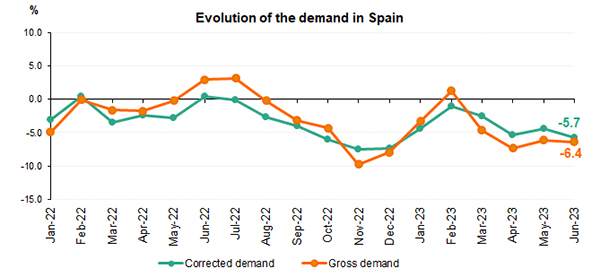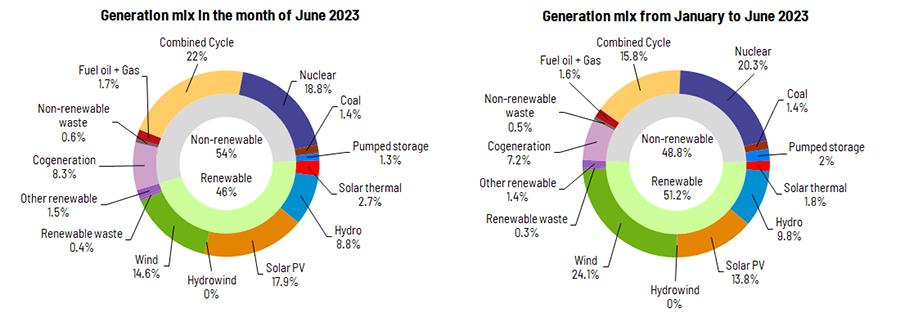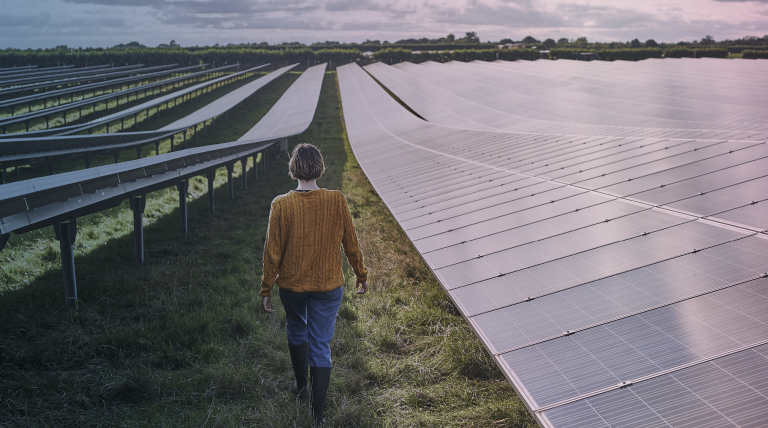For 40 years, we've been driving our country's economic and social progress. Four decades shaping Spain.
Demand for electricity in Spain fell 5.7% in June
- Renewables generated 46% of the country’s electricity this month and 65.7% of the energy mix was obtained using zero-carbon energy technologies.
- Solar photovoltaic produced 17.9% of the total energy mix in Spain and, for the first time, became the leading technology in renewable generation for the month.
- Wind power, meanwhile, continued to lead the Spanish generation mix in the first six months of 2023, with a share of 24.1%.

National electricity demand in June experienced a 5.7% decrease year-on-year after having factored in the influence of seasonal and working patterns. In gross terms, demand is estimated at 19,962 GWh, down 6.4% on June 2022.

In the first six months of 2023, Spain recorded a cumulative demand of 120,059 GWh, down 4.4% compared to the same period of 2022. Once again, after having factored in the influence of seasonal and working patterns, demand in the period fell by 3.9% compared to 2022.
In June, according to data available at the time of this press release, renewable energy sources generated 6.4% more compared to the same month in 2022, reaching a total of 9,851 GWh, which represented a 46% share of total production. For its part, electricity production obtained using zero-carbon energy technologies accounted for 65.6% of the total.
In June, one of the calendar months with the most daylight hours, solar photovoltaic registered a production of 3,838 GWh, up 19.1% year-on-year, and, for the first time, has become the leading source of renewable generation in Spain, with a share of 17.9%.
It is followed by wind, whose contribution in June stood at 3,139 GWh, representing 14.6% of the monthly mix, but which, in the first six months of 2023 as a whole, is the leading source of electricity production nationwide, with a share of 24.1%.
Hydro, with an 8.8% share of the total production in June, generated 1,880 GWh this month, showing an increase of 57.6% year-on-year.

Demand for electricity in the peninsular system
Regarding the mainland electricity system, and after having factored in the influence of seasonal and working patterns, demand for electrical energy in June was 6.1% lower than in 2022. In gross terms, peninsular demand stood at 18,653 GWh, down 6.9% year-on-year.
In the first six months of the year, electricity demand on the Spanish mainland stood at 112,982 GWh, a 4.6% decrease compared to 2022. Again, after having factored in the influence of seasonal and working patterns, demand showed a decrease of 4.1%.
Renewables as a whole generated 47.9% of the peninsular total and 68.8% of the electricity was obtained using zero-carbon energy technologies.
On the Spanish mainland, solar photovoltaic was also the leading renewable source of generation nationwide, with 18.6%, followed by wind with 15.2%.
Electricity demand in the Balearic Islands and the Canary Islands
Electricity demand in the Balearic Islands in June, after having factored in the influence of seasonal and working patterns, was 5.5% lower than in the same month in 2022. Thus, gross demand is estimated at 551,316 MWh, down 4.2% compared to June of last year. In the first six months of 2023, gross demand in the Balearic Islands is estimated at 2,708,805 MWh, down 2.6% year-on-year.
In terms of generation, combined cycle, with 65.8% of the energy produced in the Balearic Islands, was the leading source in the islands in June. For its part, renewable energy obtained using zero-carbon energy technologies in the Balearic Islands represented 12.3% of the total. In addition, this month, the subsea link between the mainland and Majorca contributed to covering 22.4% of the electricity demand in the Balearic Islands.
For its part, and after having factored in the influence of seasonal and working patterns, electricity demand in the Canary Islands increased by 4.3% year-on-year. In gross terms, demand stood at 725,779 MWh, up 4.6%. In the first six months of 2023, demand in the Canary Islands is estimated at 4,184,699 MWh, up 1% compared to the same period in 2022.
In terms of electricity generation in the Canary Islands, combined cycle, with 50.5% of the total, was also the leading technology in June. Renewables and generation obtained using zero-carbon energy technologies produced 13.3% of the production this month, with wind generating 8.9% of the total.
Consult our Daily Balance Report for more information on the National, Peninsular, Balearic Islands and Canary Islands electricity systems as at the close of June.
Downloads












